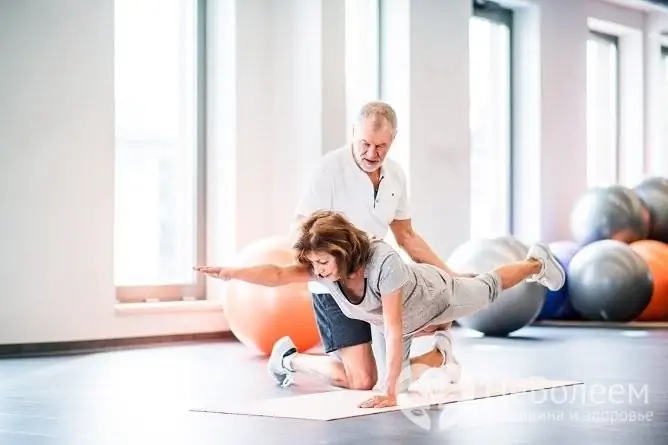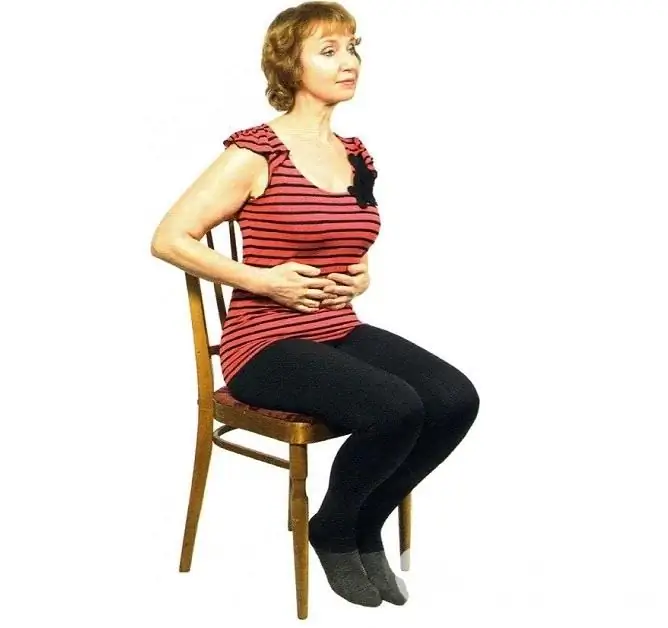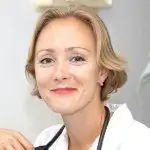- Author Rachel Wainwright [email protected].
- Public 2023-12-15 07:39.
- Last modified 2025-11-02 20:14.
Exercises for cervical osteochondrosis
The content of the article:
- Indications and contraindications for exercise
- Healing effect
- General recommendations
-
Execution techniques
- Lying exercises
- Standing exercises
- Sitting exercises
- General information about the disease
- Video
Exercises for cervical osteochondrosis, provided they are performed correctly and regularly, can significantly alleviate the patient's condition and slow down the progression of the disease.
For the first time, gymnastics is performed under the supervision of a specialist for adequate and complete mastering of the technique of movements. In the future, you can ask him to record a video or draw up a diagram with pictures to repeat the program at home. Also, with the primary appointment, the entire complex is corrected for the individual characteristics of the patient. Physiotherapy at home is prescribed with repeated courses of treatment.

The specialist must teach the patient the correct exercise technique
Indications and contraindications for exercise
Indications:
- Restoration of motor activity, exercise therapy is especially effective in the postoperative period (prevention of fibrosis).
- Maximum prolongation of the effect of conservative therapy in the remission phase.
- Creation of a dense muscular frame for the purpose of additional support function for the spinal column.
- Strengthening metabolic processes in tissues by stimulating blood circulation.
- As a preventive therapy in people with clinically and instrumentally unconfirmed diagnosis (for example, risk groups associated with a particular profession).
Exercises for osteochondrosis of the cervical spine have a number of contraindications:
- The phase of pronounced clinical manifestations (physical activity serves as an additional pain stimulus).
- Terminal stages of oncological diseases, especially in the case of involvement of bone structures.
- Decompensated diseases of the cardiovascular system (intractable arterial hypertension, angina pectoris, thrombophlebitis).
- Neurological diseases with severe destruction of cartilage and bone tissue (intervertebral hernias in the sequestration stage).
- Mental disorders (schizophrenia).
Healing effect
Provided that the exercises are performed correctly and systematically, the following positive effects occur:
- restoration of normal function of the affected joint;
- development of fibro-altered joint components (with minor damage);
- strengthening of regeneration processes in tissues at the cellular level;
- effective strengthening of the muscle frame;
- an increase in the vertical size of the deformed vertebrae.
General recommendations
Gymnastics has a number of general guidelines that must be followed to improve the quality of charging:
- Preliminary examination and establishment of an accurate diagnosis of osteochondrosis, since other treatment options may be required in the presence of diseases with similar symptoms.
- The session is preceded by a standard warm-up and muscle stretching. This is necessary to prepare all structures for the subsequent set of exercises in order to prevent sprains and muscle spasms.
- The course of treatment must be completed in full and within a strictly specified time frame. Unauthorized termination and shift of occupations is not allowed (there is a risk of falling into the acute phase of the disease).
- In treatment, the most simple techniques are used, since gymnastics can be assigned to various groups of the population (difference in gender, age). The main goal is versatility.
- It is necessary to exclude exercises that cause severe pain.
- All physical exercises alternate with relaxing ones (prevention of overstrain and spasms).
- A combination of several treatment methods is allowed (physiotherapy, exercise therapy, drug treatment).
Execution techniques
There are different methods of treating osteochondrosis using exercise therapy, which differ in sequence and duration, but have similar therapeutic effects.
| Author's technique | Characteristic |
| Bubnovsky's technique | The most popular author's technique has 60-70% positive reviews. It is required to thoroughly knead the muscles before starting gymnastics. |
| Gitt's technique | It refers more to the methods of manual therapy and has a long session time - up to 1.5 hours. In the long term, the most effective method, but research on this topic is scarce. It is permissible to perform with pain syndrome. |
| Shishonin's method | It does not require good physical fitness and has good results (up to 50%). |
| Dikul's method | It is effective to prescribe for the prevention of muscle atrophy in the postoperative period. |
| Butrimov's technique |
It has a good effect on the restoration of sensitive disorders (eliminates vertebral artery syndrome). Does not apply to the classic treatment options (mainly aimed at stretching the neck). |
When doing gymnastics at home, it is permissible to combine various techniques with the formation of the optimal one in each case.
Typical exercises for osteochondrosis are considered without detailing the author's methods.

The author's methods of treating osteochondrosis with the help of exercise therapy have been developed and applied
Lying exercises
- Lying on your stomach, make extensor movements in the thoracic and cervical spine with the head thrown back. In this case, the hands should serve as a support for the body. Quantity - 5-10 times.
- Lying on your back, make twisting movements (lifting the upper half of the body). The lower limbs may be slightly bent. Quantity - 5-10 times.
- Lying on your back, try to bring the chin to the chest as much as possible while fixing the cervical spine in the phase of maximum flexion for 10 seconds. Quantity - 5-10 times.
- In the position on all fours, produce maximum flexion and extension of the spine (simultaneous training of the thoracic and cervical regions). The number of executions is 5-10 times.
- From a reclining position (knees bent, legs under the body, abdomen touches bent limbs), make the maximum extension of the head and neck towards the arms extended forward. The number of executions is 5-10 times.
Standing exercises
Standing is required straight, feet shoulder width apart.
- Turn the head towards the right and left shoulder with fixation for 10 seconds in each position. The number of executions is 5-10 times in each direction.
- Tilt the head forward / backward, right / left with fixation in this position for 5-10 seconds. The number of exercises is 5-10 times.
- Make circular movements clockwise and counterclockwise 5 times.
- Direct the shoulder joints and head simultaneously forward, and then tilt back simultaneously. The number of executions is 5-10 times in each direction.
- Bend the whole body to the right and left with maximum extension (the cervical and thoracic spine are simultaneously involved). The number of executions is 5-10 times in each direction.
- Bend the whole body forward / backward (maximum extension of the whole body).
Sitting exercises
This is the most acceptable option for the elderly.
- Head tilts and rotations similar to those performed in a standing position.
- Turning the body to the sides with a maximum turn of the head (placing the chin behind the right or left shoulder). The number of executions is 5-10 times.
- Sitting on the floor, flex / extend the body towards the lower extremities and back (ideally, touch the lower extremities with the stomach). The number of executions is 5-10 times.
- Sitting on the floor, make half-inclinations of the body (angle no more than 40 degrees) to the right and left sides with simultaneous extension of the cervical spine. The number of executions is 5-10 times.
- Sitting on a chair, fix the upper limbs behind the back and bend the spinal column with a return to its original position. The number of executions is 5-10 times.
- Sitting on a chair with a fixed upper part of the body, tilt the head backward as much as possible with fixation for 5-10 seconds in this position. The number of executions is 5-10 times.

Elderly patients can easily perform a set of exercises while sitting on a chair
It is permissible to modify any exercise using specialized equipment (gymnastic sticks and weights). The implementation of any presented movement does not require good stretching, the patient can exercise each of them as far as possible (the main condition is the absence of excessive muscle strain).
General information about the disease
Osteochondrosis of the spine is a slowly progressive degenerative-dystrophic disease that is associated with damage to the intervertebral disc, vertebrae and neurovascular structures.
Features of development in the cervical segment of the spine (can occur at any other level):
- The disease goes through a number of stages in its development (the stage of chondrosis, the stage of instability of the vertebral discs, the stage of intervertebral hernia and the final stage of fibrosis). At each stage, there are differences in the clinical picture and treatment.
- More often occurs in persons over 45 years of age, since the degenerative natural discharge of bone tissue begins (osteoporosis phenomena).
- It has no exact cause of its occurrence and has no etiological treatment, only symptomatic.
- The classic symptom of the disease is pain of various localization and intensity.
- The initial stages of the disease can occur due to compression of the nervous or vascular structures. A feature of the cervical spine is the dominance of the vertebral artery syndrome (hypoxia of the frontal and occipital lobes of the brain and the occurrence of visual and auditory disorders).
- The cervical spine has the smallest area of the vertebrae and a disproportionate load on them (the second most frequent level at which osteochondrosis occurs, the first is lumbar).
The clinical picture is presented by four syndromes.
| Clinical syndrome | Description |
| Static | It is associated with a violation of the normal structure of the intervertebral discs (annulus fibrosus, nucleus). Typical symptoms are pain, impaired motor activity. |
| Vascular | Associated with vascular compression. Typical symptoms are a violation of sensitive activity (numbness, tingling, squeezing). |
| Neurological | It is associated with compression of the nerve roots (directly in the spinal cord or when leaving the spinal cord). Typical symptoms are local pain in the innervation zone of the affected nerve, dysfunction of innervated organs. |
| Trophic | It is associated with a malnutrition of tissues and a slowdown in regeneration processes. There are no external manifestations (it works at the cellular level). |
The syndromes are presented in order to understand the necessary points of influence when performing exercises (for example, stretching the muscles somewhat facilitates the compression of the vertebrae on nearby structures and eliminates the neurological, vascular manifestations of the disease).
Video
We offer for viewing a video on the topic of the article.

Anna Kozlova Medical journalist About the author
Education: Rostov State Medical University, specialty "General Medicine".
Found a mistake in the text? Select it and press Ctrl + Enter.






